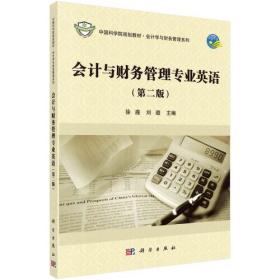
会计与财务管理专业英语(第2版中国科学院规划教材)/会计学与财务管理系列
全新正版 极速发货
¥ 36.15 6.2折 ¥ 58 全新
库存2件
广东广州
认证卖家担保交易快速发货售后保障
作者徐鹿,刘璐
出版社科学出版社
ISBN9787030561220
出版时间2021-01
装帧平装
开本16开
定价58元
货号1202207555
上书时间2024-08-07
- 最新上架
商品详情
- 品相描述:全新
- 商品描述
-
作者简介
目录
Contents
PART 1 ACCOUNTING 1
UNIT 1 Basic Accounting 2
Chapter 1 Introduction to Accounting 3
1.1 Definition of Accounting 3
1.2 Profession of Accounting 3
1.3 Types of Accounting Information 5
1.4 Measurement Bases of Financial Accounting 5
1.5 Basic Accounting Assumptions and Qualitative Characteristics 7
Chapter 2 The Accounting Equation and Double-Entry Bookkeeping 17
2.1 Accounting Elements 17
2.2 The Accounting Equation 18
2.3 Double-Entry Bookkeeping 21
Chapter 3 Accounting Cycle (Ⅰ) 29
3.1 Journal and Journalizing Transactions 29
3.2 Ledger and Posting Transactions 32
3.3 Preparing a Trial Balance 35
Chapter 4 Accounting Cycle (Ⅱ) 43
4.1 Time Period Principle and the Need for Adjustments 43
4.2 Accrual Basis Versus Cash Basis of Accounting 44
4.3 Prepare Adjusting Entries 45
4.4 The Adjusted Trial Balance and Preparation for Financial Statements 49
4.5 Worksheet 52
4.6 Closing Entries 54
4.7 The Post-Closing Trial Balance 56
4.8 The Steps in the Accounting Cycle 57
Chapter 5 Basic Financial Statements 66
5.1 Statement of Profit or Loss and Other Comprehensive Incomes 66
5.2 Statement of Changes in Owners’ Equity 67
5.3 Statement of Financial Position 68
5.4 Statement of Cash Flows 70
Chapter 6 Accounting for Merchandising Operations 76
6.1 Merchandising Activities 76
6.2 Accounting for Merchandise Purchase 78
6.3 Accounting for Merchandise Sales 81
6.4 The Adjusting and Closing Entries for Merchandisers 83
6.5 Preparing Financial Statements 85
UNIT 2 Financial Accounting 93
Chapter 7 Cash 94
7.1 Nature of Cash 94
7.2 Control of Cash 95
Chapter 8 Accounts Receivable 110
8.1 Nature of Accounts Receivable 110
8.2 Sales Discounts 111
8.3 Sales Returns and Allowances 112
8.4 Accounting for Bad Debt Expense 112
Chapter 9 Inventory 126
9.1 Nature of Inventory 126
9.2 Perpetual and Periodic Inventory Systems 127
9.3 Inventory Cost Flow Methods 128
Chapter 10 Fixed Assets 140
10.1 Definition of Fixed Assets 140
10.2 Acquisition of Fixed Assets 140
10.3 Depreciation of Fixed Assets 142
10.4 Disposal of Fixed Assets 145
Chapter 11 Intangible Assets 152
11.1 Definition of Intangible Assets 152
11.2 Classification of Intangible Assets 152
11.3 Acquisition of Intangible Assets 153
11.4 Amortization of Intangible Assets 154
11.5 Goodwill 155
Chapter 12 Liabilities 161
12.1 Definition of Liabilities 161
12.2 Characteristics of Liabilities 161
12.3 Classification of Liabilities 161
12.4 Accounting for Liabilities 162
Chapter 13 Owners’ Equity 171
13.1 Forms of Business Organizations 171
13.2 Sole Proprietorship Accounting 171
13.3 Partnership Accounting 172
13.4 Corporation Accounting 182
Chapter 14 Revenues and Expenses 198
14.1 Contents of Income Statement 198
14.2 Accounting for Revenues 199
14.3 Accounting for Expenses 201
Chapter 15 Financial Statements (Ⅰ) 210
15.1 Statement of Financial Position 210
15.2 Statement of Profit or Loss and Other Comprehensive Incomes 219
Chapter 16 Financial Statements (Ⅱ) 233
16.1 Statement of Cash Flows 233
16.2 Statement of Changes in Owners’ Equity 237
PART 2 FINANCIAL MANAGEMENT 248
Chapter 17 Overview of Financial Management 250
17.1 Main Contents of Financial Management 250
17.2 Targets of Financial Management 253
17.3 Major Tasks of Financial Managers 254
Chapter 18 Time Value of Money 257
18.1 Relationship to Payment Decisions 257
18.2 Future Value and Present Value of Single Amount 257
18.3 Future Value and Present Value of Annuity 259
18.4 Determining Annuity Value 262
Chapter 19 Interest Rate 265
19.1 Historical Interest Rates 265
19.2 Reasons for Interest Rate Changes 266
19.3 Interest Rate Quotes 267
19.4 Converting APR to EAR 267
19.5 Inflation and Real Versus Nominal Rates 268
19.6 Risks and Taxes 268
19.7 Market Interest Rate Model 269
Chapter 20 Risk and Return 271
20.1 A Single Investment 271
20.2 A Multi-Investment Portfolio 273
20.3 Risk-Return Relationship 275
Chapter 21 Financial Ratio Analysis 278
21.1 Broad Categories of Ratios 278
21.2 Profitability and Return on Capital 280
21.3 Liquidity, Gearing/Leverage and Working Capital 282
21.4 Efficiency Ratios: Control of Receivables and Inventories 285
21.5 Shareholders’ Investment Ratios 287
Chapter 22 Debt Financing 296
22.1 Short-Term Debt Financing 296
22.2 Long-Term Debt Financing 297
Chapter 23 Equity Financing 301
23.1 The Concept of Equity Financing 301
23.2 Advantages and Disadvantages of Equity Financing 301
23.3 The Factors Considered for Choosing a Method of Financing 302
23.4 The Sources of Equity Financing 302
23.5 The Methods of Equity Financing 303
Chapter 24 Capital Budgeting (Ⅰ) 308
24.1 The Importance of Capital Budgeting 308
24.2 The Processes and Principles of Capital Budgeting 309
24.3 Incremental Cash Flows of Project 309
Chapter 25 Capital Budgeting (Ⅱ) 315
25.1 Capital Budgeting Decision Criteria 315
25.2 PP 315
25.3 NPV 316
25.4 IRR 317
Chapter 26 Working Capital Management 322
26.1 Working Capital Terminology 322
26.2 Cash Management 323
26.3 Accounts Receivable Management 324
26.4 Inventory Management 325
Chapter 27 Distribution of Profits 336
27.1 The Basic Theory of Dividend Policy 336
27.2 Dividend Theories 337
27.3 Factors Influencing Dividend Decisions 339
27.4 Dividend Policies 341
Chapter 28 Financial Planning 352
28.1 The Objective of Financial Planning 352
28.2 The Benefits of Financial Planning 352
28.3 Important Elements in Financial Planning 353
28.4 The Financial Planning Model 354
28.5 The Links Between Long-Term and Short-Term Financing Decisions 355
内容摘要
本书涵盖了会计和财务管理的有关内容,分为两个部分,共28章。第一部分是会计部分,分基础会计和财务会计两个单元,共16章。基础会计单元依次介绍了会计等式、会计循环和基本的财务报表知识;财务会计单元依次介绍了资产、负债、所有者权益、收入、费用和具体的财务报表应用。第二部分是财务管理专题,共12章,依次介绍了时间价值、利率、风险、融资、投资、营运资金、利润分配和报表分析等内容。每一章后面都附有词汇表。
相关推荐
— 没有更多了 —















![会计与财务管理专业英语 ]](https://www0.kfzimg.com/sw/kfz-cos/kfzimg/10596130/86774f1ce0fefa08_s.jpg)
以下为对购买帮助不大的评价